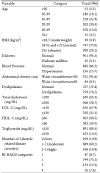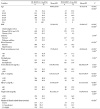References
2. McPherson K, Steel CM, Dixon JM. ABC of breast disease. Breast cancer-epidemiology, risk factors, and genetics. BMJ 2000;321(7261):624–628.
3. Boyd NF, Lockwood GA, Byng JW, Tritcher DL, Yaffe MJ. Mammographic densities and breast cancer risk. Cancer Epidemiol Biomarkers Prev 1998;7(12):1133–1144.
4. American College of Radiology. ACR BI-RADS® atlas: Breast imaging reporting and data system 5th editionth ed. Reston: American College of Radiology; 2013.
5. Carney PA, Kasales CJ, Tosteson AN, Weiss JE, Goodrich ME, Poplack SP, et al. Likelihood of additional work-up among women undergoing routine screening mammography: the impact of age, breast density, and hormone therapy use. Prev Med 2004;39(1):48–55.
6. Sellers TA, Vachon CM, Pankratz VS, Janney CA, Fredericksen Z, Brandt KR, et al. Association of childhood and adolescent anthropometric factors, physical activity, and diet with adult mammographic breast density. Am J Epidemiol 2007;166(4):456–464.
7. Jeon JH, Kang JH, Kim Y, Lee HY, Choi KS, Jun JK, et al. Reproductive and hormonal factors associated with fatty or dense breast patterns among Korean women. Cancer Res Treat 2011;43(1):42–48.
8. Jun JK, Kim MJ, Choi KS, Suh M, Jung KW. Development of a sampling strategy and sample size calculation to estimate the distribution of mammographic breast density in Korean women. Asian Pac J Cancer Prev 2012;13(9):4661–4664.
9. Kim SH, Kim MH, Oh KK. Analysis and comparison of breast density according to age on mammogram between Korean and Western women. J Korean Radiol Soc 2000;42(6):1009–1014.
10. Goh E, Shin KW, Seo YY, Ko JA, Park MS, Cho B, et al. Breast density in mammography according to body mass index(BMI) in Korean women. Korean J Health Promot Dis Prev 2008;8(4):281–286.
11. Jung JS, Kim JS, Park YM, Lee K, Park TJ. The relationship between body mass index and mammographic density in Korean women. J Korean Acad Fam Med 2008;29(11):831–837.
12. Cho JJ, Song HJ, Koh EY, Song YM, Han BK, Yun YS, et al. Mammographic breast density and risk factors of breast cancer in Korean women using multicenter study. J Korean Acad Fam Med 2006;27(1):33–41.
13. Lee S, Park HS, Kim SM, Kwon HS, Kim DY, Kim DJ, et al. Cut-off points of waist circumference for defining abdominal obesity in the Korean population. Korean J Obes 2006;15(1):1–9.
14. Basevi V, Di Mario S, Morciano C, Nonino F, Magrini N. Comment on: American diabetes association. Standards of medical care in diabetes--2011. Diabetes Care 2011;34(Suppl. 1):S11-S61. Diabetes Care 2011;34(5):e53. author relpy e54.
16. Kang JK. Concept of lifestyle-related disease. Korean J Med 2003;65(1):121–125.
17. Humphrey LL, Helfand M, Chan BK, Woolf SH. Breast cancer screening: a summary of the evidence for the U.S. preventive services task force. Ann Intern Med 2002;137(5 Part 1):347–360.
18. Grove JS, Goodman MJ, Gilbert FI Jr, Mi MP. Factors associated with mammographic pattern. Br J Radiol 1985;58(685):21–25.
19. Carney PA, Miglioretti DL, Yankaskas BC, Kerlikowske K, Rosenberg R, Rutter CM, et al. Individual and combined effects of age, breast density, and hormone replacement therapy use on the accuracy of screening mammography. Ann Intern Med 2003;138(3):168–175.
20. Banks E, Reeves G, Beral V, Bull D, Crossley B, Simmonds M, et al. Influence of personal characteristics of individual women on sensitivity and specificity of mammography in the million women study: cohort study. BMJ 2004;329(7464):477.
21. Bhang SY, Lee HJ, Kang JH, Yu BY. Associations between metabolic syndrome and three-dimensional breast density using digital mammography. Korean J Health Promot 2015;15(4):168–174.
22. Conroy SM, Butler LM, Harvey D, Gold EB, Sternfeld B, Greendale GA, et al. Metabolic syndrome and mammographic density: the study of women's health across the nation. Int J Cancer 2011;129(7):1699–1707.
23. Boyd NF, Lockwood GA, Byng JW, Little LE, Yaffe MJ, Tritchler DL. The relationship of anthropometric measures to radiological features of the breast in premenopausal women. Br J Cancer 1998;78(9):1233–1238.
24. Sung J, Song YM, Stone J, Lee K, Kim SY. Association of body size measurements and mammographic density in Korean women: the healthy twin study. Cancer Epidemiol Biomarkers Prev 2010;19(6):1523–1531.
25. Sung J, Song YM, Stone J, Lee K, Kim SY. High-density lipoprotein cholesterol, obesity, and mammographic density in Korean women: the healthy twin study. J Epidemiol 2011;21(1):52–60.
26. Meyer MR, Barton M. Estrogens and coronary artery disease: new clinical perspectives. Adv Pharmacol 2016;77:307–360.
27. Chlebowski RT, Anderson GL, Gass M, Lane DS, Aragaki AK, Kuller LH, et al. Estrogen plus progestin and breast cancer incidence and mortality in postmenopausal women. JAMA 2010;304(15):1684–1692.
28. Han M. Metabolic syndrome emerging from menopause. J Korean Soc Menopause 2011;17(3):127–135.




